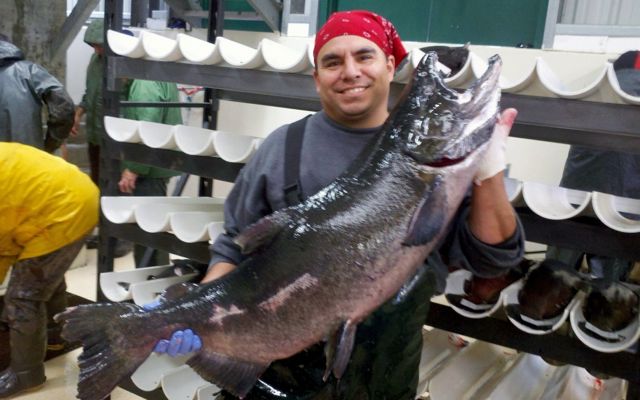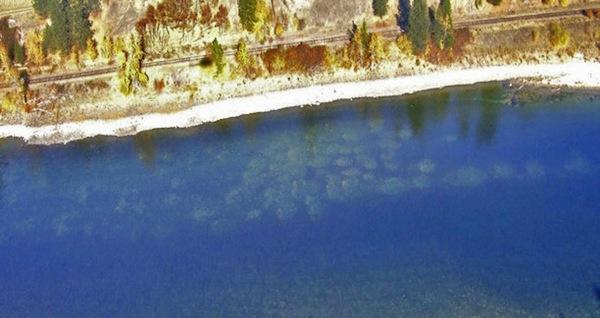forum
library
tutorial
contact

Fall Chinook Continue to
Set Records on the Snake River
by Jeremy FiveCrows
CRITFC Blog, February 4, 2016
|
the film forum library tutorial contact |

|
Fall Chinook Continue to
by Jeremy FiveCrows
|
 For the third year in a row, fall chinook returning to the Snake River have set a new record. Data released by the Nez Perce Tribe shows that a new record of 9,345 redds, or gravel nests, were built by returning adults in the Snake River Basin between Lower Granite and Hells Canyon dams last year. The previous record was set in 2014 when 6,714 redds were counted. This new record coincides with the third highest adult Snake River fall chinook return (59,300) since the four lower Snake River dams were completed in 1975.
For the third year in a row, fall chinook returning to the Snake River have set a new record. Data released by the Nez Perce Tribe shows that a new record of 9,345 redds, or gravel nests, were built by returning adults in the Snake River Basin between Lower Granite and Hells Canyon dams last year. The previous record was set in 2014 when 6,714 redds were counted. This new record coincides with the third highest adult Snake River fall chinook return (59,300) since the four lower Snake River dams were completed in 1975.
The success of the Snake River fall chinook program is the direct result of efforts to supplement existing Snake River fall chinook with biologically appropriate hatchery-reared fish.
Brought to the Brink of Extinction
In the early 1900's, Snake River fall chinook were widely distributed from the mouth of the river upstream to Shoshone Falls in southern Idaho, more than 900 miles from the ocean. As late as the 1930's, fall chinook returns in the Snake River numbered 500,000 adults.
The construction of dams on the Snake River, beginning with Swan Falls in 1901 and continuing with the Hells Canyon Dam Complex in the 1950's and Lower Snake River dams in later years, eliminated or severely degraded 530 miles -- or 80% -- of the historical habitat. The most productive of that habitat was upriver from the site of Hells Canyon Dam, which has no fish passage. A precipitous decline of Snake River fall chinook followed with only 78 wild adults observed at Lower Granite Dam in 1990.
NOAA's response to the listing of Snake River fall chinook under the Endangered Species Act in 1992 threatened the tribal fall season fishery -- the last remaining tribal commercial fishery at the time. In 1994, NOAA sought to restrict the tribal fishery under the ESA setting the stage for a potential landmark conflict between tribal treaty rights and the ESA. With the stage set, U.S. District Court Judge Malcolm Marsh warned the parties that while he was willing to hear this case, not everyone would like the outcome. The tribes were risking rights guaranteed in their treaties signed in 1855 and the federal government was risking the Endangered Species Act. Taking his warning to heart, the parties began negotiating.
The agreement brought together the Nez Perce Tribe, Washington Department of Fish and Wildlife, Confederated Tribes of the Umatilla Indian Reservation, Idaho Department of Fish and Game, U.S. Fish and Wildlife Service, NOAA Fisheries, and Oregon Department of Fish and Wildlife to restore fall chinook salmon above Lower Granite Dam. One outcome of this agreement was the authorization for the Nez Perce Tribe to develop a cutting-edge hatchery program to supplement natural chinook populations with hatchery-reared fish of the same stock. The agreement also spurred the development and issuance of Secretarial Order #3206 by the secretaries of Interior and Commerce, which sought to harmonize the federal government's duties to the tribes and the ESA.
 Now, 21 years after the program began, the Nez Perce Tribe annually releases 450,000 yearling fall chinook and 2.8 million sub-yearling fall chinook from tribal facilities. Together with the other parties and partners, a total of 5 million fish are put back into the system each year. These releases into the Snake and Clearwater rivers have increased the number of adult fall chinook returning above Lower Granite Dam. Many of which spawn naturally and are key to increasing natural-origin returns.
Now, 21 years after the program began, the Nez Perce Tribe annually releases 450,000 yearling fall chinook and 2.8 million sub-yearling fall chinook from tribal facilities. Together with the other parties and partners, a total of 5 million fish are put back into the system each year. These releases into the Snake and Clearwater rivers have increased the number of adult fall chinook returning above Lower Granite Dam. Many of which spawn naturally and are key to increasing natural-origin returns.
"The continued success of the Snake River fall chinook returns over the past 5 years strengthens the argument for carefully managed hatcheries as a tool in salmon recovery," said Anthony Johnson, Chairman of the Nez Perce Tribal Executive Committee. "This program highlights the success of salmon restoration programs and demonstrates our potential when we focus on rebuilding abundance."
Adult fall chinook salmon returns to Lower Granite Dam have increased from fewer than 1,000 adults to Lower Granite Dam annually from 1975-1995 to record counts of 56,565 adults in 2013 and 60,868 in 2014. These returns include record numbers of natural-origin fish returning to the spawning grounds, including 21,142 wild fish in 2013, 14,172 in 2014 and a preliminary estimate 16,212 in 2015. This equals approximately 28 percent of the 2015 return to the area.
The continued increase in returns of Snake River fall chinook allowed co-managers to open a fall chinook fishery in the Snake River in 2009. This was the first fall chinook fishery on the Snake River in 35 years and the fishery has occurred each year since.
"The success of the Snake River fall chinook is something this region can really be proud of," said Paul Lumley, Executive Director for the Columbia River Inter-Tribal Fish Commission. "Over the last 20 years, we've moved from the courtroom to supporting fisheries while putting a substantial number of retuning adults on the spawning grounds. This type of program should be replicated throughout the Columbia River Basin, not limited."
learn more on topics covered in the film
see the video
read the script
learn the songs
discussion forum
